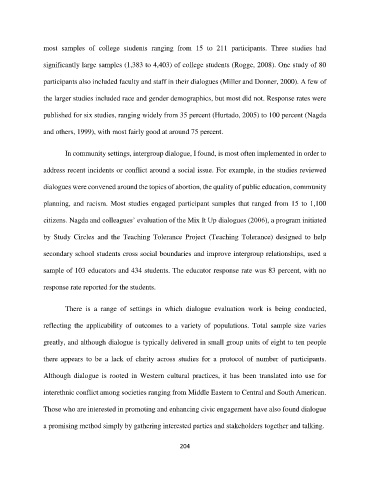Page 223 - Mike Ratner CC - WISR Complete Dissertation - v6
P. 223
most samples of college students ranging from 15 to 211 participants. Three studies had
significantly large samples (1,383 to 4,403) of college students (Rogge, 2008). One study of 80
participants also included faculty and staff in their dialogues (Miller and Donner, 2000). A few of
the larger studies included race and gender demographics, but most did not. Response rates were
published for six studies, ranging widely from 35 percent (Hurtado, 2005) to 100 percent (Nagda
and others, 1999), with most fairly good at around 75 percent.
In community settings, intergroup dialogue, I found, is most often implemented in order to
address recent incidents or conflict around a social issue. For example, in the studies reviewed
dialogues were convened around the topics of abortion, the quality of public education, community
planning, and racism. Most studies engaged participant samples that ranged from 15 to 1,100
citizens. Nagda and colleagues’ evaluation of the Mix It Up dialogues (2006), a program initiated
by Study Circles and the Teaching Tolerance Project (Teaching Tolerance) designed to help
secondary school students cross social boundaries and improve intergroup relationships, used a
sample of 103 educators and 434 students. The educator response rate was 83 percent, with no
response rate reported for the students.
There is a range of settings in which dialogue evaluation work is being conducted,
reflecting the applicability of outcomes to a variety of populations. Total sample size varies
greatly, and although dialogue is typically delivered in small group units of eight to ten people
there appears to be a lack of clarity across studies for a protocol of number of participants.
Although dialogue is rooted in Western cultural practices, it has been translated into use for
interethnic conflict among societies ranging from Middle Eastern to Central and South American.
Those who are interested in promoting and enhancing civic engagement have also found dialogue
a promising method simply by gathering interested parties and stakeholders together and talking.
204

